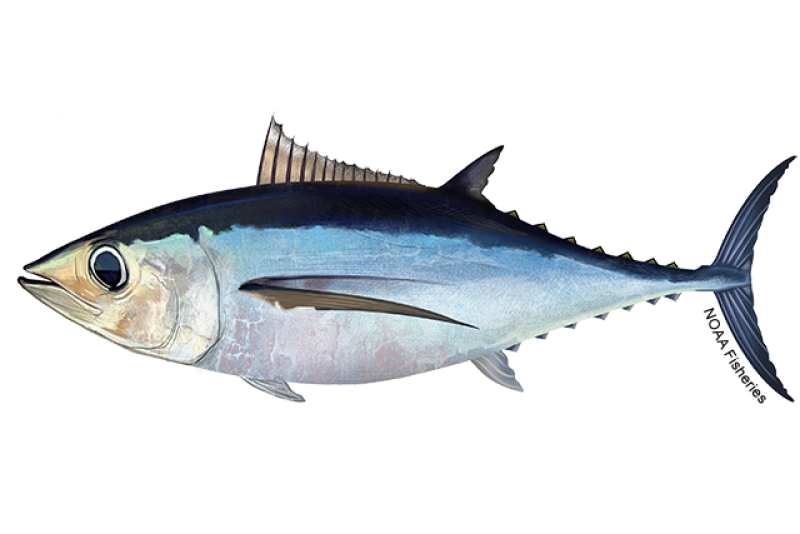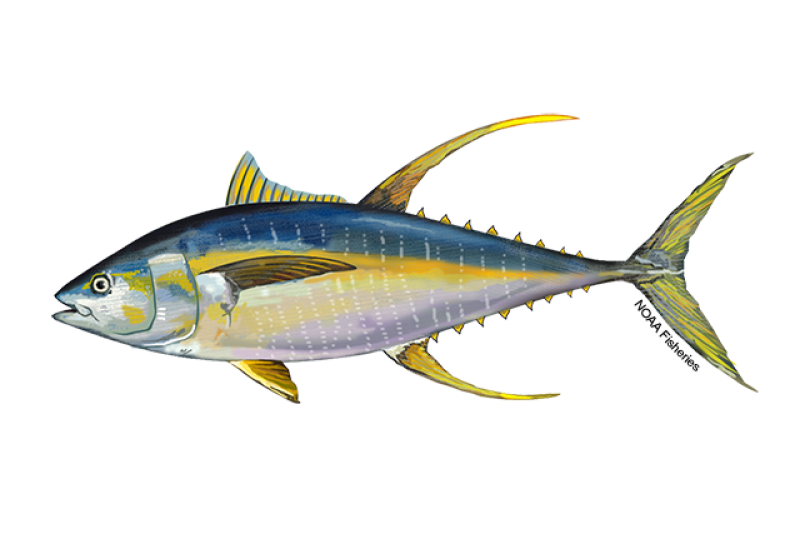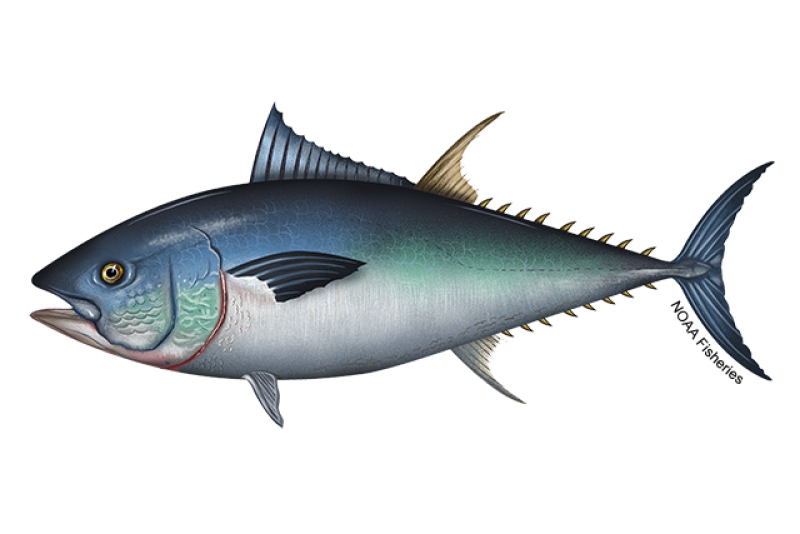About the Species
U.S. wild-caught Pacific albacore tuna is a smart seafood choice because it is sustainably managed and responsibly harvested under U.S. regulations.

Population
The stocks are not overfished.

Fishing Rate
Not subject to overfishing.

Habitat Impact
Fishing gear used to catch albacore rarely contacts the seafloor so habitat impacts are minimal.

Bycatch
Regulations are in place to minimize bycatch.
Population Status
- There are two stocks of Pacific albacore tuna: the North Pacific stock and the South Pacific stock. According to the most recent stock assessments:
- The North Pacific stock is not overfished and not subject to overfishing (2023 stock assessment). Summary stock assessment information can be found on Stock SMART.
- The South Pacific stock is not overfished and not subject to overfishing (2021 stock assessment). Summary stock assessment information can be found on Stock SMART.
Appearance
- Albacore tuna have torpedo-shaped bodies, smooth skin, and streamlined fins.
- They are metallic, dark blue on the back with dusky to silvery white coloration along the sides of the belly.
- They have exceptionally long pectoral fins, which are at least half the length of their bodies.
- The edge of the tail fin is white.
Biology
- Albacore tuna grow fast at first but more slowly with age, up to almost 80 pounds and about 47 inches long.
- Similarly sized albacore travel together in schools that can be up to 19 miles wide.
- North Pacific albacore, particularly juveniles (2 to 4 years old), typically begin their expansive migration in the spring and early summer in waters off Japan. They move into inshore waters off the U.S. Pacific coast by late summer, then spend late fall and winter in the western Pacific Ocean. The timing and distance of their migrations in a given year depend on oceanic conditions.
- Less is known about the movements of albacore in the South Pacific Ocean—juveniles move southward from the tropics when they are about a foot long, and then eastward to about 130˚ West. When the fish are mature, they return to tropical and subtropical waters to spawn.
- They’re able to reproduce when they reach 5 to 6 years old, and they live for 10 to 12 years.
- North Pacific albacore spawn between March and July in tropical and subtropical waters of the Pacific. Females broadcast their eggs near the surface, where they’re fertilized. Depending on their size, females release between 800,000 and 2.6 million eggs every time they spawn.
- Albacore can swim at speeds exceeding 50 miles per hour and cover vast areas during annual migrations.
- They have a highly evolved circulatory system that regulates their body temperature and increases muscle efficiency; a high metabolism; and high blood pressure, volume, and hemoglobin, all of which increase oxygen absorption.
- They lack the structures needed to pump oxygen-rich water over their gills so, in order to breathe, they must constantly swim with their mouths open.
- Albacore are top carnivores, preying on schooling stocks such as sardine, anchovy, and squid. They eat an enormous amount of food to fuel their high metabolism, sometimes consuming as much as 25 percent of their own weight every day.
- Larger species of billfish, tuna, and sharks eat albacore.
Where They Live
Range
- Albacore tuna are found in tropical and warm temperate waters of the Pacific, Atlantic, and Indian Oceans.
Habitat
- Albacore tuna are found in open waters of all tropical and temperate oceans.
- They are a highly migratory species, swimming long distances throughout the ocean.
- Temperature is a major factor in determining where Pacific albacore live.
- Juveniles are often found near oceanic fronts or temperate discontinuities.
- Adults are found in depths of at least 1,250 feet. They also explore deeper waters in search of prey.
Fishery Management
- NOAA Fisheries and the Pacific Fishery Management Council manage the Pacific albacore tuna fishery on the West Coast.
- Managed under the Fishery Management Plan for U.S. West Coast Fisheries for Highly Migratory Species:
- Requires commercial fishermen to obtain a permit from NOAA Fisheries and maintain logbooks documenting their catch.
- Restricts the use of longline gear in specific areas and times of the year, to minimize impacts on protected resources, including sea turtles, marine mammals, and seabirds.
- NOAA Fisheries and Western Pacific Fishery Management Council manage this fishery in the Pacific Islands.
- Managed under the Fishery Ecosystem Plan for the Pelagic Fisheries of the Western Pacific:
- Fishermen are required to have permits and to record their catch in logbooks.
- Gear restrictions, monitoring, and operational requirements to minimize bycatch.
- A limit on the number of permits for Hawaii and American Samoa longline fisheries controls participation in the fishery.
- Longline fishing prohibited in areas around the Main Hawaiian Islands, Northwestern Hawaiian Islands, Guam, the Northern Mariana Islands, and American Samoa to protect endangered Hawaiian monk seals, and reduce potential gear conflicts and localized stock depletion (when a large quantity of fish are removed from an area).
- These areas are enforced through NOAA Fisheries’ vessel monitoring system program. Longline boats must be equipped with a satellite transponder that provides real-time position updates and tracks vessel movements.
- Hawaii-based and American Samoa–based longline vessels must carry onboard observers when requested by NOAA Fisheries, in part to record any interactions with sea turtles, seabirds, and marine mammals.
- Mandatory annual protected species workshops for all longline vessel owners and operators.
- Management of highly migratory species, like Pacific albacore tuna, is complicated because the species migrate thousands of miles across international boundaries and are fished by many nations.
- Effective conservation and management of this resource requires international cooperation as well as strong domestic management.
- Two international organizations, the Inter-American Tropical Tuna Commission (IATTC) and the Western and Central Pacific Fisheries Commission (WCPFC), manage this fishery.
- These Commissions rely on the scientific advice of their staff and the analyses of the International Scientific Committee for Tuna and Tuna-like Species in the North Pacific (ISC) to develop and adopt international resolutions for conservation and management measures.
- Working with the U.S. Department of State, NOAA Fisheries domestically implements these conservation and management measures.
- In 2000, the United States established the Dolphin-Safe Tuna Tracking and Verification Program to monitor the domestic production and importation of all frozen and processed tuna products nationwide and to authenticate any associated dolphin-safe claim.
Harvest
- In 2023, commercial landings of Pacific albacore tuna totaled 6.8 million pounds and were valued at approximately $9 million, according to the NOAA Fisheries commercial fishing landings database. The majority of Pacific albacore tuna is landed in Washington and Oregon. Hawaii albacore is mostly sold fresh.
- There are also significant landings in American Samoa, averaging approximately 3 million pounds per year, most of which is canned locally.
- Gear types, habitat impacts, and bycatch:
- On the U.S. West Coast, commercial fishermen target the North Pacific stock primarily using troll and pole-and-line (bait boat) gear.
- In Hawaii, longline vessels harvest North Pacific albacore while targeting swordfish and other tunas.
- In American Samoa, longline vessels target the South Pacific stock.
- Bycatch in U.S. albacore fisheries is low. Based on limited observer data, troll and pole-and-line (bait boat) gears have insignificant levels of bycatch.
- Interactions with sea turtles can occur in longline fisheries, but extensive observer coverage in U.S. fisheries indicates these interactions are rare. U.S. longline fishermen are required to use specific tools and handling techniques to reduce the effects of bycatch.
- Several other management measures are in place, such as gear modifications and time-area closures, to limit and prevent interactions between longline gear and other species.
- Recreational fishery:
- North Pacific albacore are a popular and important recreational species.
- Off the West Coast, commercial passenger fishing vessels are required to keep logbooks to document their catch.
- There are bag limits in U.S. federal and state waters.
Scientific Classification
- Albacore tuna are found in tropical and warm temperate waters of the Pacific, Atlantic, and Indian Oceans.
- Albacore tuna are found in open waters of all tropical and temperate oceans.
- They are a highly migratory species, swimming long distances throughout the ocean.
- Temperature is a major factor in determining where Pacific albacore live.
- Juveniles are often found near oceanic fronts or temperate discontinuities.
- Adults are found in depths of at least 1,250 feet. They also explore deeper waters in search of prey.
Fishery Management
- NOAA Fisheries and the Pacific Fishery Management Council manage the Pacific albacore tuna fishery on the West Coast.
- Managed under the Fishery Management Plan for U.S. West Coast Fisheries for Highly Migratory Species:
- Requires commercial fishermen to obtain a permit from NOAA Fisheries and maintain logbooks documenting their catch.
- Restricts the use of longline gear in specific areas and times of the year, to minimize impacts on protected resources, including sea turtles, marine mammals, and seabirds.
- NOAA Fisheries and Western Pacific Fishery Management Council manage this fishery in the Pacific Islands.
- Managed under the Fishery Ecosystem Plan for the Pelagic Fisheries of the Western Pacific:
- Fishermen are required to have permits and to record their catch in logbooks.
- Gear restrictions, monitoring, and operational requirements to minimize bycatch.
- A limit on the number of permits for Hawaii and American Samoa longline fisheries controls participation in the fishery.
- Longline fishing prohibited in areas around the Main Hawaiian Islands, Northwestern Hawaiian Islands, Guam, the Northern Mariana Islands, and American Samoa to protect endangered Hawaiian monk seals, and reduce potential gear conflicts and localized stock depletion (when a large quantity of fish are removed from an area).
- These areas are enforced through NOAA Fisheries’ vessel monitoring system program. Longline boats must be equipped with a satellite transponder that provides real-time position updates and tracks vessel movements.
- Hawaii-based and American Samoa–based longline vessels must carry onboard observers when requested by NOAA Fisheries, in part to record any interactions with sea turtles, seabirds, and marine mammals.
- Mandatory annual protected species workshops for all longline vessel owners and operators.
- Management of highly migratory species, like Pacific albacore tuna, is complicated because the species migrate thousands of miles across international boundaries and are fished by many nations.
- Effective conservation and management of this resource requires international cooperation as well as strong domestic management.
- Two international organizations, the Inter-American Tropical Tuna Commission (IATTC) and the Western and Central Pacific Fisheries Commission (WCPFC), manage this fishery.
- These Commissions rely on the scientific advice of their staff and the analyses of the International Scientific Committee for Tuna and Tuna-like Species in the North Pacific (ISC) to develop and adopt international resolutions for conservation and management measures.
- Working with the U.S. Department of State, NOAA Fisheries domestically implements these conservation and management measures.
- In 2000, the United States established the Dolphin-Safe Tuna Tracking and Verification Program to monitor the domestic production and importation of all frozen and processed tuna products nationwide and to authenticate any associated dolphin-safe claim.
Harvest
- In 2023, commercial landings of Pacific albacore tuna totaled 6.8 million pounds and were valued at approximately $9 million, according to the NOAA Fisheries commercial fishing landings database. The majority of Pacific albacore tuna is landed in Washington and Oregon. Hawaii albacore is mostly sold fresh.
- There are also significant landings in American Samoa, averaging approximately 3 million pounds per year, most of which is canned locally.
- Gear types, habitat impacts, and bycatch:
- On the U.S. West Coast, commercial fishermen target the North Pacific stock primarily using troll and pole-and-line (bait boat) gear.
- In Hawaii, longline vessels harvest North Pacific albacore while targeting swordfish and other tunas.
- In American Samoa, longline vessels target the South Pacific stock.
- Bycatch in U.S. albacore fisheries is low. Based on limited observer data, troll and pole-and-line (bait boat) gears have insignificant levels of bycatch.
- Interactions with sea turtles can occur in longline fisheries, but extensive observer coverage in U.S. fisheries indicates these interactions are rare. U.S. longline fishermen are required to use specific tools and handling techniques to reduce the effects of bycatch.
- Several other management measures are in place, such as gear modifications and time-area closures, to limit and prevent interactions between longline gear and other species.
- Recreational fishery:
- North Pacific albacore are a popular and important recreational species.
- Off the West Coast, commercial passenger fishing vessels are required to keep logbooks to document their catch.
- There are bag limits in U.S. federal and state waters.
Scientific Classification
| Kingdom | Animalia | Phylum | Chordata | Class | Actinopterygii | Order | Scombriformes | Family | Scombridae | Genus | Thunnus | Species | alalunga |
|---|
Last updated by NOAA Fisheries on 04/03/2025
Featured News
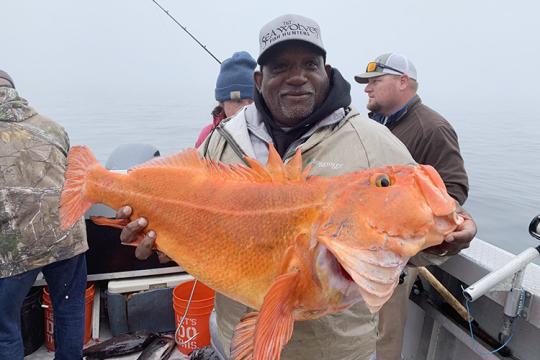
 Members gather at the 21st annual Western and Central Pacific Fisheries Commission meeting to discuss international fisheries management, November 28–December 3, 2024. Credit: NOAA Fisheries
Members gather at the 21st annual Western and Central Pacific Fisheries Commission meeting to discuss international fisheries management, November 28–December 3, 2024. Credit: NOAA Fisheries
U.S. Leads Pacific Tuna Commission Action on Climate Change and Rebuilding Plan for North Pacific Striped Marlin
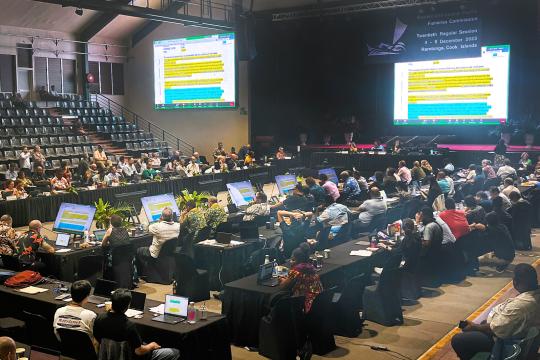 The 20th Annual Western and Central Pacific Fisheries Commission meeting at the Te Are Kariori (National Auditorium) in
Rarotonga, Cook Islands. Credit: NOAA Fisheries.
The 20th Annual Western and Central Pacific Fisheries Commission meeting at the Te Are Kariori (National Auditorium) in
Rarotonga, Cook Islands. Credit: NOAA Fisheries.
 Grilled tuna lemon with mayo. Credit: North Carolina Sea Grant/Vanda Lewis.
Grilled tuna lemon with mayo. Credit: North Carolina Sea Grant/Vanda Lewis.
Seafood Facts

Is Pacific Albacore Tuna Sustainable?
U.S. wild-caught Pacific albacore tuna is a smart seafood choice because it is sustainably managed and responsibly harvested under U.S. regulations.
Availability
Fresh from late spring to late fall and frozen year-round.
Source
U.S. wild-caught from Washington to California, Hawaii, American Samoa, and on the high seas.
Taste
Mild, rich taste.
Texture
Firm, steaky, with large, moist flakes.
Color
Light beige to almost brown when raw but turns off-white after cooking. Albacore has the lightest-colored meat of all the tunas.
Health Benefits
Albacore is a heart-healthy protein choice that is low in fat and cholesterol.
Nutrition Facts
Servings: 1; Serving Weight: 113 g (fresh); Calories: 150; Protein: 31 g; Total Fat: 2 g; Total Saturated Fatty Acids: 1 g; Carbohydrate: 0 g; Total Sugars: 0 g; Total Dietary Fiber: 0 g; Cholesterol: 45 mg; Selenium: 36.5 mcg; Sodium: 80 mgMore Information
Albacore Tuna Recipes
Albacore tuna can be grilled or seared for a delicious tuna steak. If you need some cooking inspiration, browse these recipes for grilled marinated tuna, seared albacore, and more!

Last updated by NOAA Fisheries on 04/03/2025
Seafood News
 Thomas Piecuch flips floating oyster bags on his farm (Credit: Holy Ground Oyster Company).
Thomas Piecuch flips floating oyster bags on his farm (Credit: Holy Ground Oyster Company).
Celebrating Aquaculture Week: Farming from Tide to Table
 NOAA team members adjust a prototyped turtle excluder device (TED) before sending it to divers below for continued testing on the NOAA R/V Caretta. Credit: NOAA Fisheries (ESA Permit 20339)
NOAA team members adjust a prototyped turtle excluder device (TED) before sending it to divers below for continued testing on the NOAA R/V Caretta. Credit: NOAA Fisheries (ESA Permit 20339)
Small Modifications to Turtle Excluder Devices Have Big Impacts for Gulf Sea Turtles
 Pacific oysters travel down a sorting tumbler at Salty Lady Seafood Company in Juneau, Alaska. Credit: Salty Lady Seafood Company.
Pacific oysters travel down a sorting tumbler at Salty Lady Seafood Company in Juneau, Alaska. Credit: Salty Lady Seafood Company.
 Commercial fishing boats lined up in Sitka, Alaska. Credit: Shutterstock.
Commercial fishing boats lined up in Sitka, Alaska. Credit: Shutterstock.
NOAA Fisheries Seeks Recommendations for Restoring American Seafood Competitiveness
Data & Maps
American Samoa Longline Logbook Reports 2023
Logbook summary reports for the 2023 calendar year.
American Samoa Longline Logbook Reports 2022
Logbook summary reports for the 2022 calendar year.
Hawai'i and California Longline Logbook Reports 2022
Logbook summary reports for the 2022 calendar year.
Hawai'i and California Longline Logbook Reports 2021
Logbook summary reports for the 2021 calendar year.
Research
Southwest Fisheries Science Center Stock Assessments
Our stock assessments provide information on the dynamics of fish populations and scientific information to fishery managers regarding stock status, historical and future biomass, and recruitment trends.
Fishery Monitoring for West Coast and International Fisheries
We transform fisheries data into fisheries information via summations and statistical analyses to support stock assessments, scientific studies, and national and international data reporting requirements.
Population Dynamics of Coastal Pelagic and Highly Migratory Species in the North Pacific
We conduct analyses supporting the Fishery Management Plans for coastal pelagic species and highly migratory species.
Economics and Human Dimensions of Eastern Pacific and West Coast Fisheries
We conduct research on socioeconomic dimensions to support the conservation and management of international tuna fisheries, domestic Highly Migratory Species and Coastal Pelagic Species fisheries, marine recreational fisheries, and protected species.
Last updated by NOAA Fisheries on 04/03/2025
